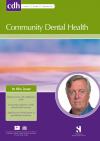Community Dental Health

- Cover Date:
- September 2014
- Print ISSN:
- 0265 539X
- Vol:
- 31
- Issue:
- 3
Effect of second mailing for consent on child dental survey results
Community Dental Health (2014) 31, 172–175 Received 4 February 2014; Accepted 13 March 2014
© BASCD 2014 doi:10.1922/CDH_3384Morgan04
Effect of second mailing for consent on child dental survey results
Introduction: Written parental consent of young children has been required for dental surveys in Wales since 2006. The 2007/08 survey produced much lower caries scores than previous surveys, believed to be associated with low participation of children with caries experience. Objective: To test the null hypothesis that decay variables from a second mailing of parental consent are no different from those generated from a first mailing. Methods: Cross-sectional caries (d3mft) survey of children aged 5-6 during 2011/12. Survey criteria complied with British Association for the Study of Community Dentistry guidance. Comparison of dental epidemiological variables generated from data collected via first and second mailing for consent. Results: The aggregate d3mft for all 7,734 children examined was 1.6. The mean d3mft for the first mailing was 1.5 (6,678 children) compared with a d3mft of 2.2 (1,056 children) for the second mailing. Equivalent data for d3mft(d3mft>0) and %d3mft>0 were: d3mft(d3mft>0) 3.8 first mailing compared with d3mft(d3mft>0) 4.1 second mailing; and %d3mft>0 39.5% first mailing compared with %d3mft>0 54.1% second mailing. Mean d3mft and %d3mft>0 showed statistically significant differences. Conclusions: Null hypothesis is rejected for d3mft and %d3mft>0. The findings suggest non-responders to the first mailing do have higher prevalence of decay than responders. To facilitate comparisons of reported decay levels, future surveys using mailed forms for consent purposes should include at least two mailings and report the number of mailings used to facilitate comparisons of reported decay levels.
Key words: epidemiology, child, dental caries, bias (epidemiology), research design, data collection
- Article Price
- £15.00
- Institution Article Price
- £0.00
- Page Start
- 172
- Page End
- 175
- Authors
- N.P. Monaghan
Articles from this issue
- Title
- Pg. Start
- Pg. End
- Experience of racism and tooth brushing among pregnant Aboriginal Australians: exploring psychosocial mediators
- 145
- 152
- Dietary intake of calcium, vitamins A and E and bleeding on probing in Sri Lankan preschoolers
- 153
- 157
- Type II diabetes and oral health: perceptions among adults with diabetes and oral/health care providers in Ghana
- 158
- 162
- Access, literacy and behavioural correlates of poor self-rated oral health amongst an Indigenous South Australian population
- 167
- 171
- Evaluation of a capacity building clinical educational model for oral health clinicians treating very young children
- 176
- 182
- The significance of motivation in periodontal treatment: The influence of adult patients’ motivation on the clinical periodontal status
- 183
- 187
